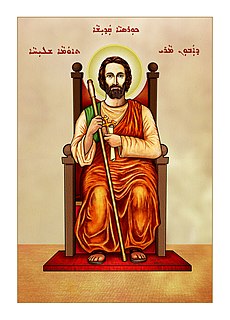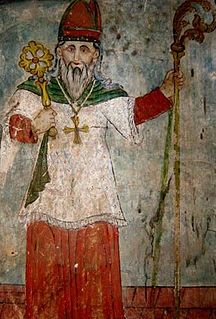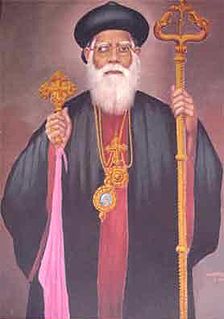
The Malankara Orthodox Syrian Church (MOSC) also known as the Malankara Church or Indian Orthodox Malankara Church, is an autocephalous Oriental Orthodox church based in Kerala, India. The church serves India's Saint Thomas Christian population. According to tradition, the Malankara Orthodox church originated in the missions of Thomas the Apostle in the 1st century(A.D.52).

The St Thomas Christians, also called Syrian Christians of India, Marthoma Nasrani, Malankara Nasrani, or Nasrani Mappila, are an ethno-religious community of Indian Christians in the state of Kerala, who currently employ the East Syriac and West Syriac liturgical rites of Syriac Christianity. They trace their origins to the evangelistic activity of Thomas the Apostle in the 1st century. The St Thomas Christians had been historically a part of the hierarchy of the Church of the East but are now divided into several different Eastern Catholic, Oriental Orthodox, Protestant, and independent bodies, each with their own liturgies and traditions. They are Malayali people and speak the Malayalam language. Nasrani or Nazarene is a Syriac term for Christians, who were among the first converts to Christianity in the Near East.

The Syro-Malankara Catholic Church, also known as the Malankara Syrian Catholic Church, is an Eastern Catholic, autonomous, particular church, in full communion with the Holy See and the worldwide Catholic Church, with self-governance under the Code of Canons of the Eastern Churches. It is one of the major archiepiscopal Churches of the Catholic Church that are not distinguished with a patriarchal title. It is headed by Major Archbishop Baselios Cardinal Cleemis Catholicos of the Major Archdiocese of Trivandrum based in Kerala, India.

The Malankara Mar Thoma Syrian Church, often shortened to Mar Thoma Church, and known also as the Reformed Syrian Church and the Mar Thoma Syrian Church of Malabar, is an autonomous Reformed Oriental church based in Kerala, India. While continuing many of the Syriac high church practices, the church is reformed in its theology and doctrines. It employs a reformed variant of the West Syriac Rite Divine Liturgy of Saint James, translated to Malayalam.

Mavelikkara is a taluk and municipality in the Alappuzha district of the Indian state of Kerala. Located in the southern part of the district on the banks of the Achankovil River.

Maramon is a small town on the Pampa River, in Thiruvalla Taluk opposite to Kozhencherry Junction in the state of Kerala, India. It is 16 km from the Thiruvalla Town headquarters, the town of Thiruvalla. Temple

Mallappally is a taluk in Kerala state in India. It is one of the five taluks that make up the Pathanamthitta district. Historically a part of the kingdom of Travancore and Cochin. It is called "Land of the BA graduates" due to English education imparted by attendants of CMS College Kottayam in the 19th century, Mallappally is the original home of many Non-resident Indians, and has one of the lowest population growth and highest literacy rates in India.

Mar Thoma I, also known Valiya Mar Thoma or Thomas de Campo, is the first native democratically elected/selected Metropolitan bishop of the Puthenkoor faction of the Saint Thomas Christians or Malankara Church. He was the last Archdeacon of the undivided St. Thomas Christians of Malankara(Maliyankara). After the death of Archdeacon George of the Cross on 25 July 1640, Parambil Thoma Kathanar was elected and enthroned as new Archdeacon, when he was less than 30 years old. He led the Church to the Coonan Cross Oath on 3 January 1653 and to the subsequent schism in Saint Thomas Christians Church. After the Coonen Cross Oath, he was elected as a Bishop by Malankara (Yogam) Association and consecrated as a Bishop at St. Mary's Church Alangad, by laying hands of 12 priests on 22 May 1653. Only two Southist churches of Kaduthuruthy and Udayamperoor and a very few people elsewhere refused to recognise him as Bishop. Any how, the archdeacon began to exercise powers of episcopal order, though he openly tried to regularize his episcopal consecration as a Bishop from the Church of Antioch. His episcopal consecration as a Bishop was regularized in the year 1665 by Mar Gregorios Abdal Jaleel the Patriarchal delegate of the Syriac Orthodox Patriarch of Antioch.. Palliveettil Mar Chandy, Kadavil Chandy Kathanar, Vengoor Geevargese Kathanar and Anjilimoottil Ittithomman Kathanar were the advisors of the bishop Thoma.

Mar Thoma III was the third metropolitan bishop who was the Malankara Metropolitan of Malankara Church in India from 1686 to 1688. His leadership was only for a short time.
Mar Thoma V was born in Pakalomattom family, one of the oldest families in Kerala and he was known as Ousep. He was the 5th Malankara Metropolitan from 1728 to 8 May 1765.During his tenure a number of bishops from Antioch arrived and he had to face a lot of problems from them. Some of these bishops were banished from the country and had to return.
Titus I Mar Thoma Metropolitan was known as Thithoos Mar Thoma Metropolitan was the second Marthoma Metropolitan (1893–1909) after the Malankara Church split as the Jacobite and reformist factions.
Mar Dionysius II, born Pulikkottil Joseph Ittoop was 10th Malankara Metropolitan from 22 March 1815 unto his death in 1816. He dethroned Mar Thoma IX and succeeded him by the favour of Col.John Munroe, then British Resident of Travancore. Despite the brevity of his reign he made lasting contributions to the Malankara Syrian Church.

The Jacobite Syrian Christian Church (JSCC), also known as the Malankara Jacobite Syrian Orthodox Church, the Jacobite Syrian Church, and the Syriac Orthodox Church in India, is an autonomous Oriental Orthodox church based in Kerala, India, and is an integral branch of the Syriac Orthodox Church of Antioch. It recognizes the Syriac Orthodox Patriarch of Antioch and All the East as supreme head of the church. It functions as a largely autonomous unit within the church, under the authority of the Catholicos of India, Baselios Thomas I. It is currently the only church in Malankara that has a direct relationship with the Syriac Christians of Antioch, which has continued since the schism of 1665 and employs the West Syriac Liturgy of Saint James.

Saint Geevarghese Mar Dionysius of Vattasseril popularly known as Vattasseril Thirumeni was the 15th Malankara Metropolitan (primate) of the Malankara Orthodox Syrian Church. In 2003, the Church declared Mar Dionysius as a saint. He is known as 'The Great Luminary of Malankara Church', a title which the Church bestowed on him in recognition of his contribution to the Church.
St. Mary's Orthodox Cathedral, Puthencavu is one of the important churches in South India, located at a village named Puthencavu, Alappuzha district in Kerala state of India. The church is one of the oldest Christian churches in the Central Travancore region of Kerala.

Geevarghese Mar Philoxenos aka Puthencavil Kochu Thirumeni was an administrator, orator and an advocate of Orthodox and the Catholicate of the Malankara Orthodox Syrian Church of India. He served as Metropolitan of Thumpamon Diocese from 1930 to 1951.
Anjilimoottil Itty Thommen Kathanar was a Kathanar of the Knanaya community of Kerala during the time of Portuguese persecution. Together with Arch Deacon Thoma Kathanar, he led the Malankara Church during the turbulent times towards the end of the Portuguese Padroado. In particular, he gave leadership to a crowd of about 25,000 members of the community at Mattancherry during the open revolt against the Portuguese in 1653 following the capture of the Syrian Bishop Ahatallah. The incident led to the Coonan Cross Oath.
Malankara Syriac Knanaya Community are part of the larger Knanaya community who are descendants of an endogamous ethnic migrant group of Syriac-Jewish Christians who arrived and settled in Kerala in the 4th or 8th century.
















